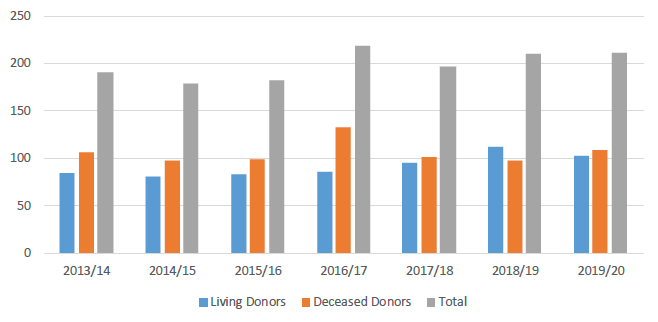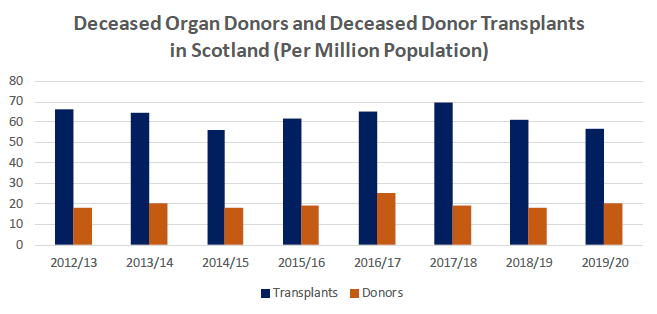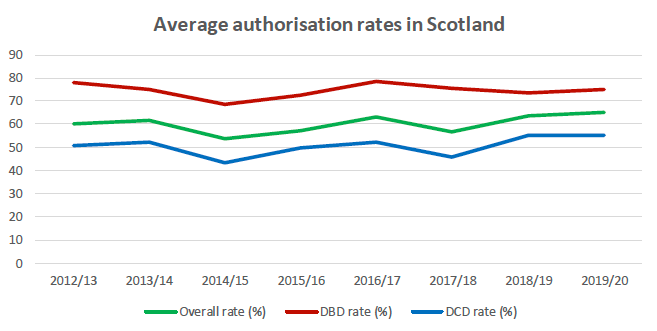Donation and transplantation: plan 2021 to 2026
The Plan sets out our priorities for increasing organ and tissue donation and transplantation over the next five years.
Background
Introduction
This plan aims to build on the improvements in donation and transplantation started following the UK Organ Donation Taskforce report[1] in 2008 and continued through the recommendations set out in A Donation and Transplantation Plan for Scotland, 2013-2020. It covers both living and deceased donation of both tissue and organs for adults and children. While there have been significant increases in living and deceased donation over the past decade, progress in some areas has been slower than we would have hoped and our progress in increasing numbers of deceased organ donors has slowed since 2013.
This plan has been developed with the members of the Scottish Donation and Transplant Group (SDTG). In considering actions for inclusion, the group agreed that the plan should focus on those actions which will or are likely to:
- increase organ and tissue transplantation and improve access to transplantation for patients,
- improve the outcomes from transplantation.
Increasing the numbers of donors and organs and tissues donated will be a key part of the plan, along with increasing the number of available organs that can be used for transplant. The Human Tissue (Authorisation)(Scotland) Act 2019 is implementing an opt-out system of authorising donation as a key part of our objective of increasing authorisation rates, and therefore in turn numbers of deceased donors, in Scotland. Therefore Scottish Government's key aims are to enable more of those who need a transplant to be able to access timely transplantation and also to use novel technologies and other techniques to ensure that as many transplants as possible work effectively for as long as possible. Alongside this, over the longer term, improving the health of people across Scotland, should reduce the numbers of individuals developing organ failure and needing transplants, which in turn should make it easier for those who do still need a transplant to access one.
This plan complements the UK Organ Donation and Transplantation Strategy and supports its objectives. Similar to the UK Strategy, we set out here our aims for the next decade, although given how much may change over that decade in this area, we have focused on recommendations which we anticipate can be delivered or where we can make significant progress in the coming five years. Work on public health promotion in particular though will take longer. This plan seeks to avoid duplicating actions already covered in the UK Strategy, particularly where actions are best taken forward on a UK-wide basis, and therefore the two documents should ideally be read together. However, this action plan does set out a number of additional Scotland-specific actions to be taken forward.
In addition, both this plan and the UK Strategy will inform the development by NHS National Services Scotland's National Services Division (NSD) of a commissioning plan for organ transplantation for patients living in Scotland. This new plan will look at the resources needed to deliver the likely demand for transplants and will succeed the existing plan – Commissioning Transplantation to 2020[2]. NSD is in the interim also working on a shorter term plan to focus on responding to the challenges of coronavirus in relation to transplantation.
While we hope that Scotland and the rest of the world will soon ensure the SARS-CoV-2 coronavirus infection is under control, we need to reflect on some of the lessons learned during 2020 to ensure this Plan takes account of the fact that the virus may continue to impact on NHS services and pose risks to patients for some time to come. We have also reflected on some of the changes made by necessity due to the virus, which may benefit patients in the longer term, such as ensuring greater use of video call technology.
An Equality Impact Assessment also accompanies this Plan and will aim to ensure that this Plan, alongside the UK Strategy, will support individuals who may have one or more of the protected characteristics. In particular, it will seek to ensure that the recommended actions will help improve outcomes in particular for disabled people and people from black and minority ethnic communities.
Achievements from the 2013-2020 Plan
The 2013-2020 Plan set out 21 recommendations, grouped under five separate priorities. Some of these recommendations are actions which are expected to continue post-2020, such as: delivering high-profile awareness campaigns on donation, continuing targeted awareness-raising with minority ethnic (particularly South Asian) communities, revising and keeping the Schools Pack up to date and training days for Procurator Fiscal staff.
Most of the recommendations are either complete or ongoing (for example, some require annual publications or awareness raising, but are essentially now part of the day to day approach to donation). However, there are a few recommendations where implementation is not yet finalised or has not progressed. In particular, for recommendation 10, we will continue to encourage closer working with the island NHS Boards and more remote hospitals to ensure people living in those areas and NHS staff have awareness about deceased donation and so opportunities for transferring potential donors to other hospitals could be considered, where appropriate, in discussion with a patient's family.
A small number of the recommendations are no longer being progressed. For example, recommendation 7 - the Category II Donation after Circulatory Death (DCD) pilot for patients experiencing cardiac arrest outside a hospital is no longer continuing. However, it could potentially be reconsidered in future if appropriate, learning lessons from the pilot evaluation. In addition, the Scottish Government explored with NHS Grampian the potential for piloting a 'whole hospital' approach to donation. This was not ultimately progressed, although recommendations from the review of Organ Donation Committees (recommendation 17) are already encouraging all mainland NHS Boards to take a whole hospital approach to organ and tissue donation involving a wide range of teams and Departments across their hospitals; as a result, it was felt a pilot was no longer necessary.
Chart 1 below shows that some progress has been made in increasing living donor numbers over the course of the 2013-2020 Plan, while numbers of deceased donors have remained fairly constant overall.

In addition, the 2013-2020 Plan set out ambitious targets for donation, transplantation and authorisation rates. It aimed by 2020 to achieve the following targets in Scotland:
- Overall deceased donation rates would increase from 17.9 per million population in 2012/13 to 26 per million population.
- Overall transplantation rates in Scotland from deceased donors would increase from 65.8 to 74 per million population.
- Family authorisation rates in donation after circulatory death (DCD) would increase from around 50% to around 80%.
- Family authorisation rates in donation after brainstem death (DBD) would increase from around 78% to around 85%.
Charts 2 and 3 below show that we have made progress in some areas and in some years, but have unfortunately not achieved the ambitious targets which were set.

Source – NHSBT

Source - NHSBT
We will continue to monitor these rates throughout the period covered by this Action Plan and our aim will still be to see increases in all these figures over the next five years. However, donation and transplantation rates, along with authorisation rates, do fluctuate constantly for a wide range of reasons, many of which are outwith the control of NHS staff. Therefore, we have not set separate Scottish targets for the Action Plan period.
This Plan sets out seven key priority areas covering a range of areas of both living and deceased donation and transplantation, with recommended actions grouped under each of these sections.
Contact
There is a problem
Thanks for your feedback